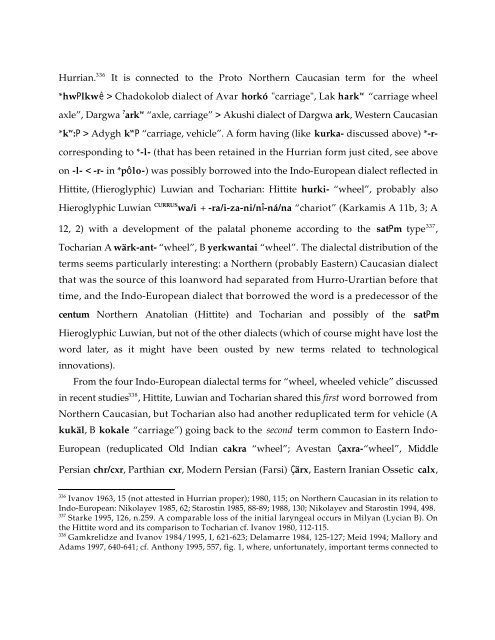Comparative Notes on Hurro-Urartian, Northern Caucasian
Comparative Notes on Hurro-Urartian, Northern Caucasian
Comparative Notes on Hurro-Urartian, Northern Caucasian
You also want an ePaper? Increase the reach of your titles
YUMPU automatically turns print PDFs into web optimized ePapers that Google loves.
Hurrian. 336 It is c<strong>on</strong>nected to the Proto <strong>Northern</strong> <strong>Caucasian</strong> term for the wheel<br />
*hwPlkwê > Chadokolob dialect of Avar horkó "carriage", Lak hark w “carriage wheel<br />
axle”, Dargwa ? ark w “axle, carriage” > Akushi dialect of Dargwa ark, Western <strong>Caucasian</strong><br />
*k w :P > Adygh k w P “carriage, vehicle”. A form having (like kurka- discussed above) *-r-<br />
corresp<strong>on</strong>ding to *-l- (that has been retained in the Hurrian form just cited, see above<br />
<strong>on</strong> -l- < -r- in *pôlo-) was possibly borrowed into the Indo-European dialect reflected in<br />
Hittite, (Hieroglyphic) Luwian and Tocharian: Hittite hurki- “wheel”, probably also<br />
Hieroglyphic Luwian CURRUS wa/i + -ra/i-za-ni/nî-ná/na “chariot” (Karkamis A 11b, 3; A<br />
12, 2) with a development of the palatal ph<strong>on</strong>eme according to the satPm type 337 ,<br />
Tocharian A wärk-ant- “wheel”, B yerkwantai “wheel”. The dialectal distributi<strong>on</strong> of the<br />
terms seems particularly interesting: a <strong>Northern</strong> (probably Eastern) <strong>Caucasian</strong> dialect<br />
that was the source of this loanword had separated from <strong>Hurro</strong>-<strong>Urartian</strong> before that<br />
time, and the Indo-European dialect that borrowed the word is a predecessor of the<br />
centum <strong>Northern</strong> Anatolian (Hittite) and Tocharian and possibly of the satPm<br />
Hieroglyphic Luwian, but not of the other dialects (which of course might have lost the<br />
word later, as it might have been ousted by new terms related to technological<br />
innovati<strong>on</strong>s).<br />
From the four Indo-European dialectal terms for “wheel, wheeled vehicle” discussed<br />
in recent studies 338 , Hittite, Luwian and Tocharian shared this first word borrowed from<br />
<strong>Northern</strong> <strong>Caucasian</strong>, but Tocharian also had another reduplicated term for vehicle (A<br />
kukäl, B kokale “carriage”) going back to the sec<strong>on</strong>d term comm<strong>on</strong> to Eastern Indo-<br />
European (reduplicated Old Indian cakra “wheel”; Avestan Çaxra-“wheel”, Middle<br />
Persian chr/cxr, Parthian cxr, Modern Persian (Farsi) Çärx, Eastern Iranian Ossetic calx,<br />
336 Ivanov 1963, 15 (not attested in Hurrian proper); 1980, 115; <strong>on</strong> <strong>Northern</strong> <strong>Caucasian</strong> in its relati<strong>on</strong> to<br />
Indo-European: Nikolayev 1985, 62; Starostin 1985, 88-89; 1988, 130; Nikolayev and Starostin 1994, 498.<br />
337 Starke 1995, 126, n.259. A comparable loss of the initial laryngeal occurs in Milyan (Lycian B). On<br />
the Hittite word and its comparis<strong>on</strong> to Tocharian cf. Ivanov 1980, 112-115.<br />
338 Gamkrelidze and Ivanov 1984/1995, I, 621-623; Delamarre 1984, 125-127; Meid 1994; Mallory and<br />
Adams 1997, 640-641; cf. Anth<strong>on</strong>y 1995, 557, fig. 1, where, unfortunately, important terms c<strong>on</strong>nected to





